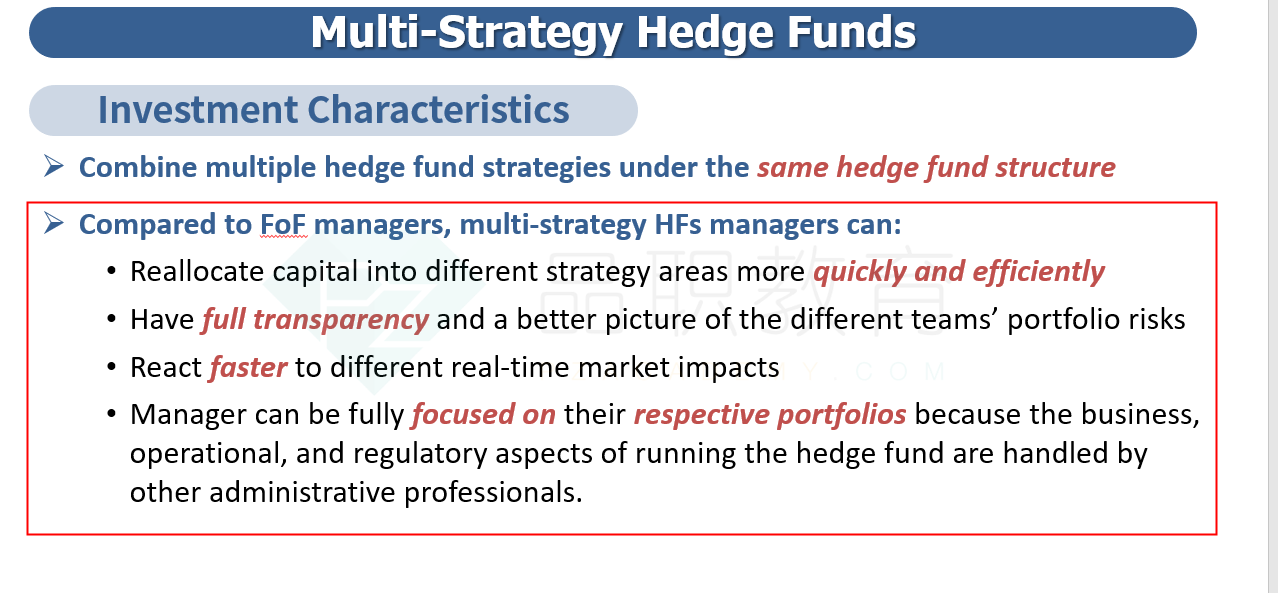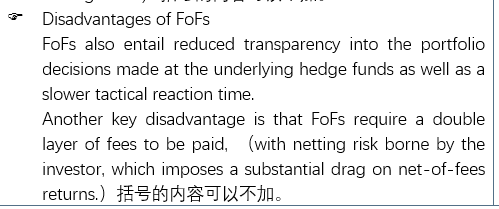NO.PZ2019122802000018
问题如下:
Sushil Wallace is the chief investment officer of a large pension fund. Wallace wants to increase the pension fund’s allocation to hedge funds and recently met with three hedge fund managers. These hedge funds focus
on the following strategies:
Hedge Fund A: Specialist—Follows relative value volatility arbitrage
Hedge Fund B: Multi-Manager—Multi-strategy fund
Hedge Fund C: Multi-Manager—Fund-of-funds
After a significant amount of internal discussion, Wallace concludes
that the pension fund should invest in either Hedge Fund B or C for the
diversification benefits from the different strategies employed.
However, after final due diligence is completed, Wallace recommends
investing only in Hedge Fund B, noting its many advantages over Hedge
Fund C.
Discuss two advantages of Hedge Fund B relative to Hedge Fund C with respect to investment characteristics.
选项:
解释:
a) Multi-strategy managers like Hedge Fund B can reallocate capital into different strategy areas more quickly and efficiently than would be possible by a fund-of-funds (FoF) manager like Hedge Fund C. The multi-strategy manager has full transparency and a better picture of the interactions of the different teams’ portfolio risks than would ever be possible for FoF managers to achieve. Consequently, the multi-strategy manager can react faster to different real-time market impacts—for example, by rapidly increasing or decreasing leverage within different strategies depending upon the perceived riskiness of available opportunities.
b) The fees paid by investors in a multi-strategy fund can be structured in a number of ways, some of which can be very attractive when compared to the FoFs’ added fee layering and netting risk attributes. Conceptually, FoF investors always face netting risk, whereby they are responsible for paying performance fees due to winning underlying funds while suffering return drag from the performance of losing underlying funds. Even if the FoF’s overall performance is flat or down, FoF investors must still pay incentive fees due to the managers of winning funds.
这块考点是教材的内容,例题也有,需要背诵。
基础班讲义例题 p126关于FOF的费用计算
例如 FOF 收1%管理费,10%绩效费
而底层的A基金 分别2%管理费,20%绩效费
而底层的B基金 分别2%管理费,20%绩效费
那么如果1年后, A基金赚gross return 20%, B基金亏损5%
net of fee return底层的A基金=20-2-3.6=14.4%
net of fee return底层的B基金=-5-2=-7%
gross retrun of FOF=14.4%*0.5-7%*0.5=3.7%
net return of FOF=3.7-1-0.27=2.43%
问题1. 如果 同样是多策略的话,该怎么计算net return呢?
问题2.FOF is subject to netting risk, 和 inability to net performance fees 是同一个概念吗?
FOF is tow layer of fees 和inability to net performance fees 是同一个概念吗?
如果描述FOF的1个缺点,以上只是1个点而已吗?
问题3.多策略 是absorb netting risk 对吗? 这个这怎么理解 吸收了 netting risk,






